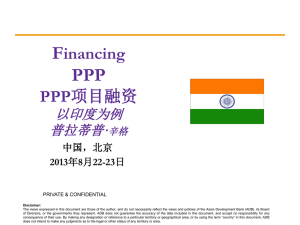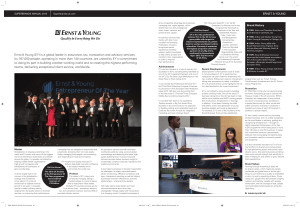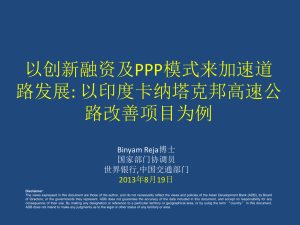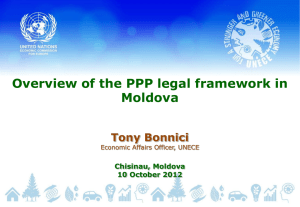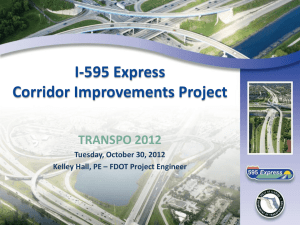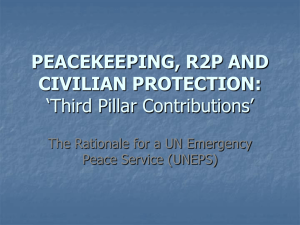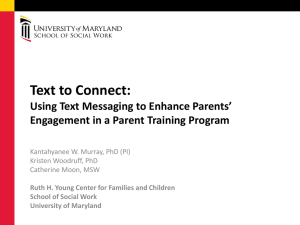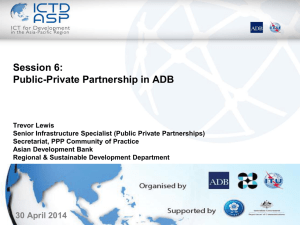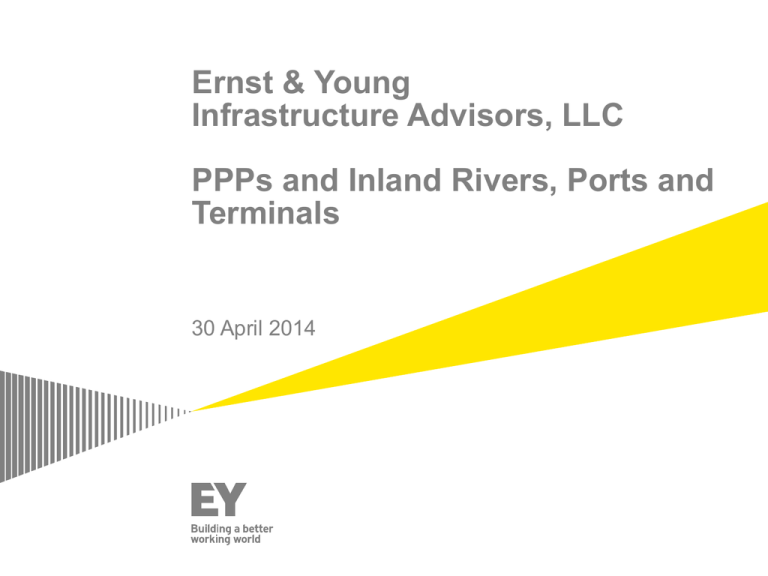
Ernst & Young
Infrastructure Advisors, LLC
PPPs and Inland Rivers, Ports and
Terminals
30 April 2014
Growing market for public private partnerships
►
►
►
►
US examples include:
►
Port of Miami Tunnel (closed)
►
I-595 Corridor Improvements and Express Lanes (closed)
►
RTD Denver P3 Eagle (closed)
►
Long Beach Courthouse (closed)
►
Goethals Bridge (closed)
►
Port of Baltimore Seagirt Marine Terminal (closed)
►
Numerous other toll projects and facilities
Considerable interest for transit as well as social infrastructure
(courthouses, schools, etc.)
Being applied to toll facilities with toll revenues accruing to the public
owner – e.g., I-595, Goethals, I-4
Many closed examples internationally (Canada, UK, etc.)
Page 2
PPP Example- Seagirt Marine Terminal
►
Public-Private Partnership between Maryland Port
Administration and Ports America Chesapeake
►
50-year concession signed in 2010
►
About $105 million of immediate improvements required
under concession, plus future maintenance
►
Shipping companies pay concessionaire for use of
terminal
Page 3
PPP Example- Port of Miami Tunnel
►
Public-Private Partnership between Florida Department of
Transportation (FDOT) and Miami Access Tunnel (MAT)
►
35-year concession agreement signed 2009
►
MAT bears construction risk
►
FDOT pays milestone payments to MAT during
construction, then availability payments
►
FDOT collects any tolls on tunnel
Page 4
Presentation title
Methods of project delivery
►
Design-Bid-Build (DBB)
►
Design-Build (DB)
►
Design-Build-Finance (DBF)
►
Design-Build-Operate-Maintain (DBOM)
►
Design-Build-Finance-Operate-Maintain (DBFOM)
Page 5
Design-Bid-Build
(DBB)
Project roles – Conventional project delivery
Page 6
Government
Designer
Tax-exempt
public debt
Operator or government
Contractor(s)
Public-Private
Partnership
(DBFOM)
Design-Build (DB)
Project roles – Alternative project delivery
Page 7
Government
DB contractor
Tax-exempt
public debt
Operator or government
Government
Equity investors
Concessionaire
DB contractor
Operator
Lenders
PPP – More than just financing
►
►
►
►
►
Who bears the risks of construction overruns, delays, operational
underperformance, revenue shortfalls, higher than expected lifecycle
costs, and/or unexpected or more frequent major maintenance?
A PPP can permit the public sector to adjust the timing of its
payments.
A project must be sufficiently defined and sufficiently large to attract
bidders.
Public trust is compromised if the performance and cost assumptions
used to justify spending and dedicated taxes or other commitments
are not achieved.
Whether or not a PPP is ultimately warranted, considering a full range
of delivery options fosters communication among disciplines and can
lead to better outcomes and understanding of risks.
Page 8
DBB
Comparing public expenditure profiles
35
Year of expenditure
(real dollars)
DBFOM
$250
$200
Availability Payments
$150
$100
$50
35
$0
1
2
3
4
5
6
7
8
9
10
(Note: these are very general approximations and conventional chart assumes major maintenance expenditures are smoothed as
contributions to reserves)
Page 9
Understanding equity
►
►
►
Cannot borrow 100% of an expected revenue stream
Need a cushion or “coverage” – risk capital that absorbs financial
impact of poor performance
The coverage revenue is equity’s return – or risk
Simplified example for illustration purposes: 1.2x debt service coverage
Equity Return
Expenses
Debt Service
Revenues
1 2 3 4 5 6 7 8 9 10 11 12 13 14 15 16 17 18 19 20 21 22 23 24 25 26 27 28 29 30
Years
Page 10
Understanding debt
►
The public sector does not face the same credit risk in a
PPP that equity and lenders face.
►
Low-cost debt can facilitate a PPP.
►
►
►
Page 11
Conduit issuers, tax exempt debt and private activity bonds all have
roles.
TIFIA is an important lender for US transportation PPPs, but has
limitations on repayment from federal funds.
WRDA and WIFIA could play a similar role to TIFIA, but any
limitations on the source of repayment will need to be considered.
Structuring a PPP
►
►
►
►
Defining the business model – how will the concessionaire earn
revenue and over what period?
Begin with the project’s specific characteristics and public goals
►
Seek efficiencies
►
Optimize risk allocation – construction risk, traffic or volume risk
Develop performance specifications
Be sure that the business model align interests: private partner should
maximize profit by meeting public goals
Page 12
Contact Information
Matthew Hobby
Senior Vice President
Ernst & Young Infrastructure Advisors, LLC
Tel. (212) 773-5615
matthew.hobby@ey.com
Mike Parker
Senior Managing Director
Ernst & Young Infrastructure Advisors, LLC
Tel. (215) 448-3391
mike.parker@ey.com
Page 13
EY | Assurance | Tax | Transactions | Advisory
About EY
EY is a global leader in assurance, tax, transaction and advisory services. The
insights and quality services we deliver help build trust and confidence in the
capital markets and in economies the world over. We develop outstanding leaders
who team to deliver on our promises to all of our stakeholders. In so doing, we
play a critical role in building a better working world for our people, for our
clients and for our communities.
EY refers to the global organization, and may refer to one or more, of the member
firms of Ernst & Young Global Limited, each of which is a separate legal entity.
Ernst & Young Global Limited, a UK company limited by guarantee, does not
provide services to clients. For more information about our organization, please
visit ey.com.
Ernst & Young LLP is an EY member firm operating in the US. Ernst & Young
Infrastructure Advisory, LLC is an affiliate thereof and a registered municipal
advisor.
© 2014 Ernst & Young LLP.
All Rights Reserved.
1402-1208926_NY
ED None
This material has been prepared for general informational purposes only and is not intended to
be relied upon as accounting, tax, or other professional advice. Please refer to your advisors for
specific advice.
ey.com


